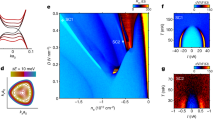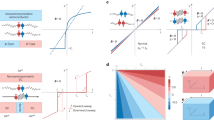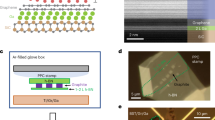Abstract
The proximity effect is a central feature of superconducting junctions that plays a key role in many devices and can be exploited in the design of new systems with quantum functionality1,2,3,4,5,6,7,8,9,10,11,12. Recently, exotic proximity effects have been observed in various systems, including superconductor–metallic nanowires5,6,7 and graphene–superconductor structures4. However, it is still not clear how superconducting order propagates spatially in a heterogeneous superconductor system. Here we report on intriguing junction geometry effects in a heterogeneous system consisting of electronically two-dimensional superconducting islands on a metallic substrate. Depending on the local geometry, the superconducting gap induced at the metallic surface sometimes decays within ∼ 20 nm of the superconductor, and sometimes survives at distances that are several coherence lengths from a superconductor. We show in particular that the curvature of the junction plays an essential role in the proximity effect.
This is a preview of subscription content, access via your institution
Access options
Subscribe to this journal
Receive 12 print issues and online access
$259.00 per year
only $21.58 per issue
Buy this article
- Purchase on SpringerLink
- Instant access to full article PDF
Prices may be subject to local taxes which are calculated during checkout




Similar content being viewed by others
Change history
16 March 2015
In the version of this Letter originally published the article number in reference 6 contained a typographical error and should have read 247003. This has now been corrected in the online versions of the Letter.
References
Gueron, S. et al. Superconducting proximity effect probed on a mesoscopic length scale. Phys. Rev. Lett. 77, 3025–3028 (1996).
Belzig, W. et al. Quasiclassical Green’s function approach to mesoscopic superconductivity. Superlatt. Microstr. 25, 1251–1288 (1999).
Pannetier, B. & Courtois, H. Andreev reflection and proximity effect. J. Low Temp. Phys. 118, 599–615 (2000).
Dirks, Travis et al. Transport through Andreev bound states in a graphene quantum dot. Nature Phys. 7, 386–390 (2011).
Pillet, J. D. et al. Andreev bound states in supercurrent-carrying carbon nanotubes revealed. Nature Phys. 6, 965–969 (2010).
Wang, J. et al. Proximity-induced superconductivity in nanowires: Minigap state and differential magnetoresistance oscillations. Phys. Rev. Lett. 102, 247003 (2009).
le Sueur, H. et al. Phase controlled superconducting proximity effect probed by tunnelling spectroscopy. Phys. Rev. Lett. 100, 197002 (2008).
Usadel, K. D. The diffusion approximation for superconducting alloys. Phys. Rev. Lett. 25, 507–509 (1970).
Nazarov, Yu. V. Novel circuit theory of Andreev reflection. Superlatt. Microstr. 25, 1221–1231 (1999).
Kamenev, A. & Levchenko, A. Keldysh technique and non-linear sigma model: Basic principles and applications. Adv. Phys. 58, 197–319 (2009).
Belzig, W., Bruder, C. & Schn, G. Local density of states in a dirty normal metal connected to a superconductor. Phys. Rev. B 54, 9443–9448 (1996).
Cuevas, J. C. et al. Proximity effect and multiple Andreev reflections in diffusive superconductor normal-metal superconductor junctions. Phys. Rev. B 73, 184505 (2006).
Ganz, E. et al. Growth and morphology of Pb on Si(111). Surf. Sci. 257, 259–273 (1991).
Seehofer, L., Falkenberg, G., Daboul, D. & Johnson, R. L. Structural study of the close-packed two-dimensional phases of Pb on Ge(111) and Si(111). Phys. Rev. B 51, 13503–13515 (1995).
Hupalo, M. et al. Atomic models, domain-wall arrangement, and electronic structure of the dense Pb/Si(111)- phase. Phys. Rev. B 66, 161410 (2002).
Qin, S. Y., Kim, J., Niu, Q. & Shih, C. K. Superconductivity at the two-dimensional limit. Science 324, 1314–1317 (2009).
Zhang, T. et al. Superconductivity in one-atomic-layer metal films grown on Si(111). Nature Phys. 6, 104–108 (2010).
Eom, D., Qin, S., Chou, M. Y. & Shih, C. K. Persistent superconductivity in ultrathin Pb films: A scanning tunnelling spectroscopy study. Phys. Rev. Lett. 96, 027005 (2006).
Kim, J. et al. Universal quenching of the superconducting state of two-dimensional nanosize Pb-island structures. Phys. Rev. B 84, 014517 (2011).
Bardeen, J., Cooper, L. N. & Schrieffer, J. R. Theory of superconductivity. Phys. Rev. 108, 1175–1204 (1957).
Tinkham, M. Introduction to Superconductivity 2nd edn (Dover, 1996).
Ozer, M. M., Thompson, J. R. & Weitering, H. H. Hard superconductivity of a soft metal in the quantum regime. Nature Phys. 2, 173–176 (2006).
Dubos, P., Courtois, H., Buisson, O. & Pannetier, B. Coherent low-energy charge transport in a diffusive S–N–S junction. Phys. Rev. Lett. 87, 206801 (2001).
Ohta, H. & Matsui, T. Nanometer SNS junctions as quantum-well devices. IEEE Trans. Appl. Supercond. 7, 2814–2817 (1997).
Sipr, O. & Gyorffy, B. L. Interpretation of bound states in inhomogeneous superconductors: The role of Andreev reflection. J. Phys. Condens. Matter 8, 169–191 (1996).
Zhou, F., Charlat, P., Spivak, B. & Pannetier, B. Density of states in superconductor–normal metal–superconductor junctions. J. Low Temp. Phys. 110, 841–850 (1998).
Acknowledgements
We are grateful to L. Glazman and A. Kamenev for discussions. This work was supported by DMR-0906025, Welch Foundation F-1672, ARO W911NF-09-1-0527 and NSF DMR-0955778.
Author information
Authors and Affiliations
Contributions
J.K. and C-K.S. designed and coordinated the experiments; J.K. and H.N. carried out the experiments; V.C., G.A.F. and A.H.M. performed the theoretical calculations; J.K., V.C., G.A.F., H.N., A.H.M. and C-K.S. analysed the data; J.K., G.A.F. and C-K.S. wrote the paper.
Corresponding author
Ethics declarations
Competing interests
The authors declare no competing financial interests.
Supplementary information
Supplementary Information
Supplementary Information (PDF 831 kb)
Rights and permissions
About this article
Cite this article
Kim, J., Chua, V., Fiete, G. et al. Visualization of geometric influences on proximity effects in heterogeneous superconductor thin films. Nature Phys 8, 464–469 (2012). https://doi.org/10.1038/nphys2287
Received:
Accepted:
Published:
Issue date:
DOI: https://doi.org/10.1038/nphys2287
This article is cited by
-
Anomalous superconducting proximity effect of planar Pb–RhPb2 heterojunctions in the clean limit
npj Quantum Materials (2022)
-
Field-induced quantum breakdown of superconductivity in magnesium diboride
NPG Asia Materials (2021)
-
Visualization of superconducting materials
SN Applied Sciences (2020)
-
Giant proximity effect in single-crystalline MgB2 bilayers
Scientific Reports (2019)
-
Acoustic extraordinary transmission manipulation based on proximity effects of heterojunctions
Scientific Reports (2019)



